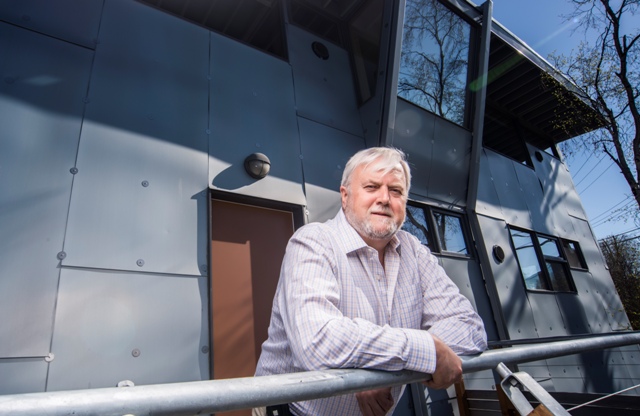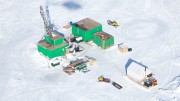Robert Gannicott, the man who built Canada’s largest diamond mining company, Dominion Diamond (TSX: DDC; NYSE: DDC) and a pioneer of Canada’s diamond scene for 25 years, has died.
Gannicott passed away on Aug. 3, at age 69, after a two-year battle with leukemia.
One of the first and most successful entrants into the Lac de Gras diamond rush in the Northwest Territories in the early 1990s, Gannicott is being remembered as a visionary and innovator, as well as for his vast contributions to Canada’s North.
With Grenville Thomas, he played an integral role at Aber Diamond in finding the Diavik mine. Gannicott then led the company through a series of transactions to become Dominion Diamond — the world’s third largest diamond miner after De Beers and Alrosa.
A transplant from England, Gannicott travelled to Canada when he was 19. Heading up to Yellowknife, he soon found work at the Giant mine as a raise-miner’s assistant.
“He got in with the exploration crowd here,” says another longtime Yellowknife exploration stalwart Lou Covello, a founder of Aurora Geosciences.
A big man with an equally big personality, the friendly and down-to-earth Gannicott fit right in with the vibrant exploration community in the city. The burgeoning scene attracted many other ex-pats, including Grenville Thomas, who had immigrated to Canada from Wales. The two met socially in the late ’60s, Thomas recalls, although it would be another 15 years before they would actually work together.
“He was young and enthusiastic,” says Thomas, who’s now chairman of diamond explorer North Arrow Minerals (TSXV: NAR). “We became good friends. I have pictures of him at my wedding in ’68.”
Gannicott left Yellowknife in the early ‘70s to study geology at Carleton University in Ottawa and then spent about a decade working for Cominco in Europe, Greenland and North Africa.
The lure of the north — strengthened by his experiences in Canada’s North and Greenland — held on to Gannicott as he started his own exploration ventures.
In the 1980s, he started an exploration company called West Viking with Lee Barker to look for gold in Iceland and one called Platinova that was involved in Greenland. Thomas, who was running two of his own companies, Highwood Resources and its subsidiary Aber Resources, was involved with both. Both men, who had reconnected in the early eighties during a chance meeting on the street in Toronto, served as directors of each others’ companies.
As an explorer, Gannicott was a risk taker and often employed unusual methods to get things done.
To carry out a drill program at one Platinova project on the northern coast of Greenland located at 85° north, Thomas says Gannicott convinced a northern airline to land 727 planes right on the sea ice.
“I don’t know how many people have flown jets onto sea ice, but that’s what we did — and that was Bob again,” he said.
Even in his early days before he struck out on his own, Gannicott seemed ahead of his time, says Gary Vivian, president of Aurora Geosciences.
“He was always knowledgeable and he always had a vision. Even when he was with Cominco, he was an outside the box thinker, he was probably 15 or 20 years ahead of most of his contemporaries,” Vivian says.
Gannicott’s inventive nature came in handy at work, but also in his offtime.
On a rafting trip with Gannicott and some friends in the early 1990s down the Nahanni River in the Northwest Territories, Thomas recalls that one of the rafts had a slow leak and had to be pumped up with air every day.
All was fine until someone left the pump behind.
“There was no way we were going to go back to get it, so Bob made a pump out of plastic stuff we had — cans, plastic bottles, duct tape and that sort of thing,” Thomas says. “It worked! It’s in the museum in Fort Simpson.”
‘He fell in love with diamonds’
In November 1991, news broke about Dia Met Minerals and BHP Billiton’s (LSE: BLT) discovery of microdiamonds in Lac de Gras.
“Between us, we decided that we should get involved in the diamond thing,” says Thomas, who conceded that they, like almost everyone else in Canada, knew very little about the topic.
With the guidance of diamond expert Chris Jennings, West Viking and Aber staked adjoining land packages in the Lac de Gras area soon after the Dia Met discovery.
By springtime, the two companies had merged to combine their land package, with Aber, a public company with easier access to financing, taking over West Viking.
And after a few months of fundraising and talking to potential partners, Aber made a deal with Rio Tinto subsidiary Kennecott that would see it fund the first $10 million in exploration and carry Aber for 40%.
Jenning’s advice turned out to be invaluable: the Diavik discovery was made in 1994. The extremely rich mine, which has both very high grades and high-quality diamonds, began production in 2003.
But Gannicott’s interest in diamonds only grew with the discovery. In 1999, as Diavik moved into the development stage, Gannicott took over from Thomas as Aber’s CEO, while Thomas remained a director until 2006.
“Bob was a very intelligent, smart, inventive character,” Thomas says. “I was an exploration guy and I’m still doing exploration. This was the stage where it needed someone who could take it into production and really get into it.”
Before long, Gannicott became very knowledgeable about diamonds, Thomas recalls.
“He fell in love with diamonds — he took a keen interest in diamonds right from the beginning.”
As head of Aber, Gannicott plotted an unconventional growth strategy for the diamond producer.
The usual path to growth — through acquiring other projects and potentially becoming a mine operator — was not an ideal option in the early 2000s, as the exploration space was extremely competitive. “Everything out there was expensive and very high risk,” Gannicott told Diamonds in Canada in May 2013.
Looking for insight into the diamond market and how to get the best price for Aber’s share of production from Diavik, Gannicott purchased the luxury jewelry brand Harry Winston Diamond in two transactions in 2004 and 2006. With the second purchase, Aber changed its name to Harry Winston Diamond, fully embracing the retail side of the business.
The controversial move was typical “outside the box” thinking for Gannicott, says Aurora’s Gary Vivian.
“I can’t say whether it was a positive or a negative thing to become a marketer of diamonds with the Harry Winston transaction, but I know Bob was always looking at ways to make the business better,” Vivian says. “Even though he was a diamond producer, he was looking at a way to grow the business through the marketing side.”
Aber paid US$266 million in total and invested another US$36 million into the retail business.
In January 2013, the company sold sold the retail unit to Swatch Group for US$750 million plus the assumption of US$250 million in related debt.
“The idea of acquiring Harry Winston of course wouldn’t have occurred to someone like me,” says Thomas. “A lot of people didn’t like the idea, but he got the support of the board and he did it. A lot of people criticized it and continued to criticize it until eventually they sold it for twice what they paid for it.”
The sale paid for a second transformational transaction for the company. In November 2012, Harry Winston bought BHP’s interest in Ekati for US$500 million. (BHP declared its stake in Ekati for sale in November 2011.)
With the move back to mining, the company changed identity again — this time to Dominion Diamond.
For the first time an operator of a diamond mine, Dominion has forged ahead with the development of the Jay project at Ekati. (The Jay pipe is in the property’s Buffer zone, in which Dominion holds 65.3% interest. Dominion owns a 88.9% interest in the main Core zone at Ekati.)
Development of the large and high-grade pipe, where mining is slated to begin in late 2022, has extended Ekati’s mine life by 10 years with closure now slated for 2033.
With the change in business, Gannicott moved Dominion’s headquarters from Toronto to Yellowknife — where Aber’s office was originally located.
“He had several reasons for doing it. I think mainly, to increase the efficiency of the operations and to show Dominion’s presence in Yellowknife,” says Lou Covello.
However, Gannicott also felt strongly that the North should see a greater share of the wealth created through its mines.
“I think that went a long way to hiring more local people — not only from Yellowknife, but from all of the surrounding communities, and even communities in Nunavut and up on the Arctic coast,” Covello explains.
‘A true northerner’
Gannicott was well respected in the mining industry for being a “straight shooter,” says Gary Vivian.
“Bob was always about business — he worked hard, he probably worked 12, 15 hours a day for almost every day of his life,” Vivian said. “He had a passion for trying to find new things.”
Gannicott earned respect and goodwill in government circles as well as in the mining sector.
“I think he was a true northerner and a visionary northerner who went out and helped develop the North through diamonds,” said Bob McLeod, Premier of the Northwest
Territories, in a telephone interview.
Gannicott’s passion for Canada’s North grew out of his many experiences there, including the fact that Yellowknife was the first place he settled in Canada, McCleod notes.
“Bob lived in Yellowknife for many years before he moved the headquarters to Yellowknife,” he says. “He always thought that if you worked in the North, you should live in the North. He was always looking for ways to increase the benefits and the value added to the North.”
Gannicott took medical leave from Dominion in November 2014, returning in July 2015. At that point, he stepped down as CEO, but retained his position as chairman. In January 2016, Gannicott stepped down as chairman.
However, the imprint he left on both Dominion and Canada’s diamond sector is a lasting one.
Brendan Bell, who succeeded Gannicott as CEO of Dominion said Gannicott was a pillar of the Canadian diamond industry who built Canada’s largest independent diamond
producer from the ground up.
“Bob was an astute executive and exceptional leader, as well as a good personal friend and mentor,” Bell said in a statement to Diamonds in Canada. “He had a love of and was fascinated by diamonds and the diamond industry. He delighted in explaining the intricacies of diamonds, from exploration to mining to polished stones. He loved the North, and his legacy will always be intertwined with that of the Northwest Territories and Dominion Diamond.”
Adds Covello: “The Northwest Territories and Nunavut and Yellowknife and the rest of the communities in western Nunavut and all of the NWT owe him a huge thanks and debt for his foresight and bringing Dominion Diamonds to the north.”
Gannicott left instructions for a foundation to be set up in his name that will support the indigenous people of the Northwest Territories.
— This article originally appeared in the November 2016 issue of Diamonds in Canada.




Be the first to comment on "Bob Gannicott’s lasting legacy"